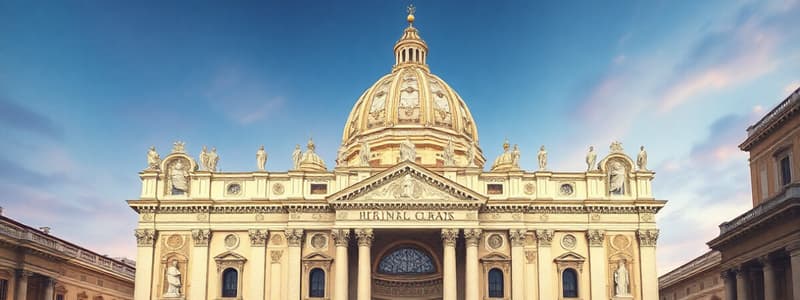Podcast
Questions and Answers
Wat was een van de belangrijkste bijdragen van Donato Bramante aan de architectuur in Rome?
Wat was een van de belangrijkste bijdragen van Donato Bramante aan de architectuur in Rome?
- De overgang naar een monumentale en klassieke stijl (correct)
- Het promoten van Manneristische ontwerpen
- Het ontwerpen van het Colosseum
- De ontwikkeling van de gotische stijl
Wat typeert het ontwerp van de St. Pieter's Basiliek volgens Bramante?
Wat typeert het ontwerp van de St. Pieter's Basiliek volgens Bramante?
- Geen gebruik van klassieke elementen
- Complexe gotische detaillering
- Een centraal plan met een grote koepel (correct)
- Een lange, traditionele basilica
Welke ontwerpprincipes stonden centraal in Bramante's architectuur?
Welke ontwerpprincipes stonden centraal in Bramante's architectuur?
- Symmetrie en proportionele relaties (correct)
- Exclusief gebruik van moderne elementen
- Chaos en asymmetrie
- Voorkeur voor kleine, intrigerende structuren
Wat was de functie van de klassieke elementen in Bramante's ontwerpen?
Wat was de functie van de klassieke elementen in Bramante's ontwerpen?
Wat is het Tempietto een voorbeeld van?
Wat is het Tempietto een voorbeeld van?
Welke vorm heeft het Tempietto?
Welke vorm heeft het Tempietto?
Hoe heeft Bramante invloed gehad op latere architecten?
Hoe heeft Bramante invloed gehad op latere architecten?
Wat was een radicale verandering in Bramante's ontwerp voor de St. Pieter's Basiliek?
Wat was een radicale verandering in Bramante's ontwerp voor de St. Pieter's Basiliek?
Flashcards
Bramante's stijl
Bramante's stijl
Een architecturale stijl gekenmerkt door duidelijkheid, balans en harmonie, met hernieuwde toepassing van klassieke elementen zoals kolommen en bogen, geïnspireerd door Romeinse ruïnes en klassieke theorieën.
St. Peter's Basilica (initieel ontwerp)
St. Peter's Basilica (initieel ontwerp)
Een kerkgebouw met een centraal ontwerp, ontworpen door Bramante, kenmerkend voor de renaissance en een afwijking van de traditionele basilicale vorm.
Tempietto
Tempietto
Een klein tempel-achtig bouwwerk in Rome, ontworpen door Bramante, dat klassieke elementen vertoont en een voorbeeld is van zijn vaardigheid met klassieke principes.
Romeinse ruïnes
Romeinse ruïnes
Signup and view all the flashcards
Centraal ontwerp
Centraal ontwerp
Signup and view all the flashcards
Hoge Renaissance
Hoge Renaissance
Signup and view all the flashcards
Klassieke elementen
Klassieke elementen
Signup and view all the flashcards
Bramante's invloed
Bramante's invloed
Signup and view all the flashcards
Study Notes
Donato Bramante's Architectural Contributions in Rome
- Bramante (1444-1514) was a key figure in the High Renaissance, particularly in Rome.
- His work marked a significant departure from the earlier artistic styles prevalent in the region.
- He spearheaded the transition to a more monumental and classical style, breaking from the Gothic and Mannerist traditions.
- Bramante's architectural style was characterized by a clear, ordered design, and the reintroduction of classical architectural elements.
- His designs were heavily influenced by Roman ruins and classical architectural theory.
St. Peter's Basilica
- Bramante's most famous work was his design for St. Peter's Basilica. This initial design, however, was not fully realized during his lifetime.
- His design for St. Peter's, a large central plan, was a radical departure from the traditional basilican plan.
- The central plan design featured a large dome and a central space meant to evoke a sense of awe and grandeur.
- Bramante's central plan at St. Peter's Basilica was inspired by ancient Roman architecture
Bramante's Design Principles
- Bramante focused on clarity, balance, and harmony in his designs.
- He employed classical elements like columns, arches, and pediments in a sophisticated and innovative manner.
- The use of these architectural elements was not merely decorative but served to communicate the structural integrity and strength of the building.
- Symmetry and proportional relationships were crucial aspects of his designs, often based on mathematical principles.
- His emphasis on central symmetry and balanced proportions was a departure from previous design conventions.
Tempietto
- The Tempietto, a small temple-like structure, stands as a masterpiece of Bramante's early architectural career.
- Designed in the courtyard of San Pietro in Montorio in Rome, the Tempietto is an example of Bramante's mastery of classical principles.
- It employs classical architectural orders (e.g., columns, entablatures), reflecting the revival of classical forms.
- The Tempietto's circular form and classical detail are highly evocative of ancient Roman architectural motifs, and it was a central inspiration for later designers and architects.
- Its precise proportions and the masterful integration of architectural elements made the Tempietto a prototype for Renaissance architecture.
Influence On Later Architects
- Bramante's impact on architectural thought and practice extended far beyond his own lifetime.
- He paved the way for other architects to embrace classical forms and principles.
- Many following Renaissance architects, including Michelangelo, were influenced by his innovative designs and approach.
- Michelangelo's subsequent design for St. Peter's Basilica demonstrated the profound impact of Bramante's influence.
- Other important Renaissance architects, throughout Europe, were also significantly impacted by Bramante's designs and principles.
Studying That Suits You
Use AI to generate personalized quizzes and flashcards to suit your learning preferences.
Description
Dit quiz behandelt de architectonische bijdragen van Donato Bramante, een belangrijke figuur van de Hoge Renaissance in Rome. Leer over zijn invloedrijke ontwerp van de Sint-Pietersbasiliek en de overgang naar een meer monumentale en klassieke stijl, weg van de gotische en maniëristische tradities.
